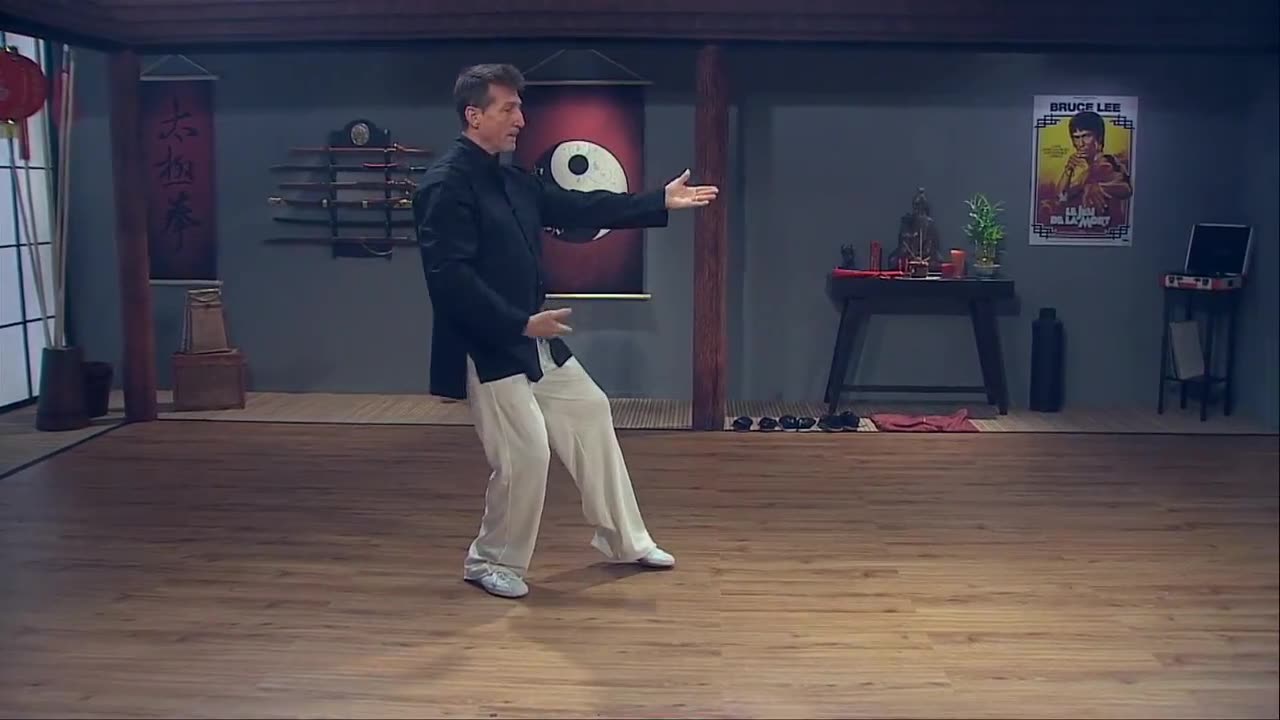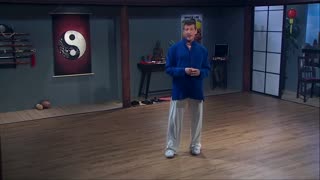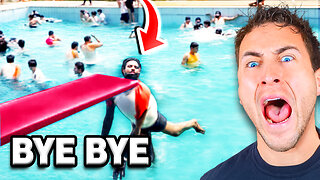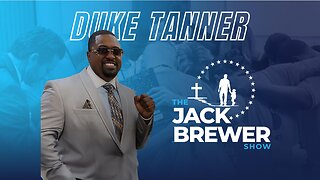Premium Only Content

05. Taming The Monkey Mind
We’ve all heard of the phrase, “the monkey mind.” The monkey
represents our uncontrolled impulses, our uncontrolled thoughts
flying from one side to another. The monkey mind creates our drive for
instant gratification, desires, and fight or flight responses. In tai chi, we
learn to tame the monkey mind. And in this lecture, we’ll take a look at how,
along with learning two new moves.
Empty and Full
● When we learned to walk like a cat in an earlier lecture, we
learned that the first step is to shift the weight entirely. This is
called emptying and filling. On the external level, empty and full
refer to weight distribution.
● The foot that bears weight is full. The foot that has no weight is
empty. The principle is to separate or to distinguish. To distinguish
or to make distinctions is to identify what something is and what
something is not.
● The body is divided into three sections: upper, lower, and middle.
The lower body is heavy, solid, rooted, and continuously moving
back and forth between empty and full. By contrast, the upper
body is light, soft, and insubstantial. The middle is flexible; it turns
and rotates.
● Another tai chi principle is to loosen the back. A reason the low
back might not rotate enough is that it is tight.
Shǒu huī pípá (“The Hands Strum the Lute”)
● We’ll start with a movement called shǒu huī pípá, or “the hands
strum the lute”). The actual name of the musical instrument here
is pipa, which is similar to the lute. It is typically played in a seated
position, with the sound box on the lap or knee and the neck
pointing up. One hand (usually the left) makes chords on the neck,
while the other hand plucks the strings.
The pipa is often played to accompany tai chi practice, and many
songs are composed on the pipa especially for tai chi. Partly, the
reason for this is that the name appears in the list of fundamental
tai chi postures. The music of the pipa is also rippling, mellow, and
continuous; many people say that the pipa sounds the way that tai
chi movement looks. Finally, many masters point out that the tai
chi body is aligned in the same way that the neck and head of the
pipa aligns straight over the body.
● From the final bow step of brush knee, shift the weight entirely
onto the left foot and bring the right foot halfway closer. Step down
onto the right foot entirely, picking up the left foot, then replacing it
down lightly on the left heel, making an empty step.
● As the weight returns to the right foot, the waist will turn to the right
45 degrees. As the left foot replaces, the waist turns back to the
left until the hips and torso are squarely facing east.
● As the waist turns to the right, the left arm floats up until it is
shoulder high. As the waist returns to the left, the left elbow sinks,
and the forearm rotates outward until the palm faces in toward the
centerline of the body.
● During the waist’s right-left rotation, the right arm arcs slightly
outward, downward, and inward until the palm lines up just below
the left elbow (but four to five inches to the right). As the arm arcs
outward, the forearm rotates inward so that the palm faces down.
As the arm arcs downward, the elbow sinks, and the forearm
rotates outward until the palm faces in toward the centerline of
the body.
Jìn bù bān lán chuí (“Travel Forward and Back Fist” [bān],
“Parry” [lán], and “Punch” [chuí])
● The next move in this lesson is jìn bù bān lán chuí, which in
English translates to “travel forward and back fist” (bān), “parry”
(lán), and “punch” (chuí).
● Pivot to the left, turn the waist to the left, and turn the left toes
out 45 degrees. Then, step down onto the left foot and bring the
right foot up to form a t-step. Step out with the right foot, landing
lightly on the heel. Turn the waist to the right; pivot to the right
on the right heel, turning the right toes out 45 degrees; and step
forward with the left foot to form a bow step. Don’t forget to leave a
channel between the feet.
● As the waist turns to the left, rotate the right forearm inward,
angling the arm downward, and form a loose fist. Sweep the right
fist upward, and as the waist turns to the right, extend the elbow to
make a back fist, striking with the back of the fist nose high.
● As the weight transfers to the right foot (in preparation for the left
foot stepping out to a bow step), the waist turns to the right and the
right fist withdraws to the right hip.
● When the waist first begins to turn left and the left toes pivot out,
the left forearm rotates inward, turning the palm slightly downward.
As the right hand executes the back fist, the left elbow slightly
sinks down. When the waist turns to the right and the right fist
withdraws to the hip, the left elbow extends forward (though not
completely; keep the elbow rounded). The left palm actually pats
downward as if blocking.
● As the weight shifts forward to complete the bow step, punch
forward with the right fist, finishing just past the left palm.
The Monkey Mind
● Every time that qi energy circulates around the body it refines
itself. This process is known as cultivation, and cultivation is how a
tai chi master gains power.
● The opposite of willpower is whim power. Willpower correlates
with intention, while whim power correlates with impulses caused
by the monkey mind.
● If you learn to control your impulses by focusing on your intention,
you actually gain mastery over your life and your qi. We have to
gain mastery to practice.
● The body is cultivated through physical practice. It’s not always
easy, and it’s not always fun—like getting up early in the morning
to stretch—but it’s necessary.
● Character, meanwhile, is cultivated by merit and virtue. Merit is
an external attribute, and virtue is an internal one. We accumulate
virtue by performing meritorious acts like acts of compassion and benevolence. These meritorious acts are done because we
contain the monkey mind. We use our intention to be mindful.
● Struggling strangles the flow of qi, and can prevent someone from
being a compassionate person, a meritorious person. Hanging
onto thoughts, ideas, preconceptions, and prejudices also
strangles the flow of qi.
-
 31:36
31:36
Mastering Tai Chi
1 year ago24. Another River To Cross
368 -
 17:51
17:51
TheRoyaltyAutoService
14 hours agoIs Flat Rate Ruining The Auto Repair Industry?!
541 -
 LIVE
LIVE
BEK TV
22 hours agoTrent Loos in the Morning - 8/28/2025
407 watching -
 LIVE
LIVE
The Bubba Army
21 hours agoMinneapolis Shooter Story Unfolds! - Bubba the Love Sponge® Show | 8/28/25
5,488 watching -
 26:00
26:00
DeVory Darkins
1 day ago $10.23 earnedDemocrat Mayor HUMILIATES himself during painful interview as Trump makes SHOCKING Announcement
29.2K78 -
 22:14
22:14
Ohio State Football and Recruiting at Buckeye Huddle
1 day agoOhio State Football: Everything Steve Sarkisian Said About the Buckeyes This Week
12.2K -
 1:19:55
1:19:55
TruthStream with Joe and Scott
1 day agoLisa, Michelle and Carole join Joe for Healing and Inspiration. Next healing will be on Aug 28th at Noon and 4pm eastern https://www.balancingbodyandsoul.com/?ref=TRUTHSTREAMSHOW
5.93K1 -
 10:32
10:32
Nikko Ortiz
16 hours agoFunniest Fails Of The Month
29.5K3 -
 28:59
28:59
The Jack Brewer Show
13 hours agoThe Jack Brewer Show S1 EP5 Charles Duke Tanner on Redemption, Fatherhood & Second Chances #podcast
2.03K -
 15:33
15:33
Bearing
23 hours agoSEPTUM RING THEORY 💥 Are Nose Ring Girls ALL INSANE LIBERALS?! 💀🤣
6.25K55